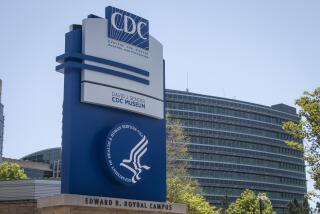Health Network Called Unready for Bioterror
- Share via
BERKELEY — California’s public health networks are ill-equipped to handle a large-scale bioterrorism attack due to decades of insufficient government funding, academics, nurses, doctors and health officials told a legislative committee examining the state’s preparedness this week.
Like most states, the experts said Tuesday, California has put too little money into public health programs, resulting in a health network that is understaffed and overworked but on the front lines of a potential bioterrorism attack.
“The system has been strained for a long time, long before the September attacks,” Rich Eisner, a regional administrator with the California Office of Emergency Services, told the Assembly Health Committee.
Emergency rooms already are “bursting at the seams” in many parts of the state--and if a mass outbreak occurred “we don’t know where we would be putting all the patients,” said Barbara Pletz, an emergency medical services administrator in San Mateo County. Even relatively mild flu outbreaks have proven difficult for emergency rooms in recent years, county officials said.
Surveillance of disease trends--the way public officials often detect unusual patterns and learn about a budding epidemic--also is lacking, other health officials said.
And California has failed to provide sufficient training for public health professionals through its public universities, said Art Reingold, an epidemiologist at the UC Berkeley School of Public Health who has a quarter-century of experience fighting infectious diseases.
In fact, UCLA nearly closed its School of Public Health several years ago, Reingold said, and Berkeley soon will have to share a new facility with other programs after its existing building is demolished due to seismic safety concerns.
Although the public health officials lamented the historical lack of financing, they acknowledged that their programs are unlikely to receive much extra cash soon due to the state’s worsening economy.
Reingold, who serves on another terrorism task force assembled by Gov. Gray Davis, said he understood that California’s financial picture is deteriorating, and that the state’s looming budget deficit, expected to be between $8 billion and $14 billion next year, will force politicians to make difficult decisions.
But, he said, public health should be a top priority because only government has the resources to protect people from attacks with deadly bacteria such as anthrax. State and local health professionals have no system to report outbreaks of disease electronically, and must spend a lot of time compiling written reports, he said, citing an example of the limitations that could hamper a speedy emergency response.
“No tax-rebate check is going to allow me to buy a public health system” as an individual, Reingold said.
Health Committee Chairwoman Helen Thomson (D-Davis), a former nurse, listened to the suggestions and said she will make recommendations to the larger legislative task force headed by Assembly Speaker Bob Hertzberg (D-Sherman Oaks). But she reflected the realities of the state’s current condition when she told the academics that a planned education bond issue might be the best hope to improve public health facilities at state colleges.
In another bid to bolster their funding, health officials want to place an initiative on the March ballot to increase state sales taxes by a quarter of a cent to cover terrorism-related public health costs.
Beth Capell, a lobbyist for Health Access of California, a coalition of more than 200 consumer, community and labor groups, said the tax money would be used to bolster trauma and emergency rooms and watch for and track the spread of diseases. It also would help provide health care to more Californians by expanding county and community clinics.
*
Times staff writer Julie Tamaki contributed to this report.
More to Read
Sign up for Essential California
The most important California stories and recommendations in your inbox every morning.
You may occasionally receive promotional content from the Los Angeles Times.










